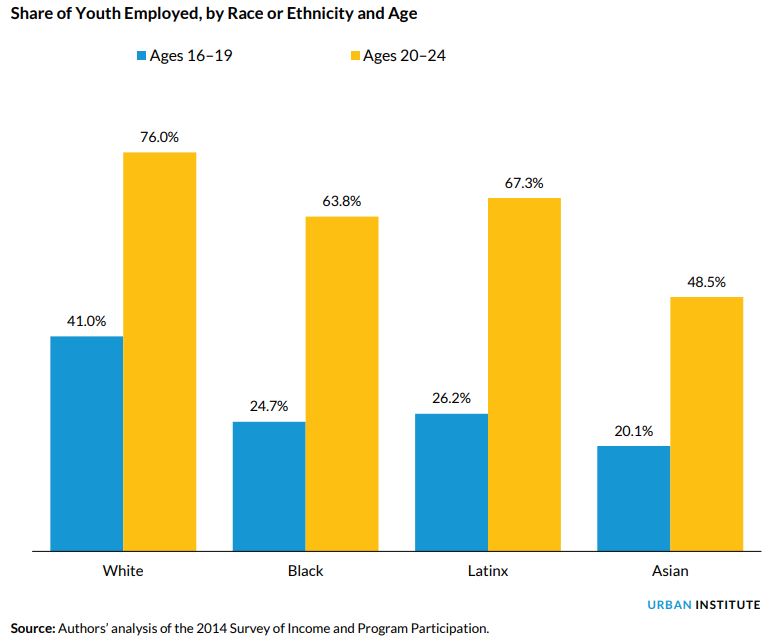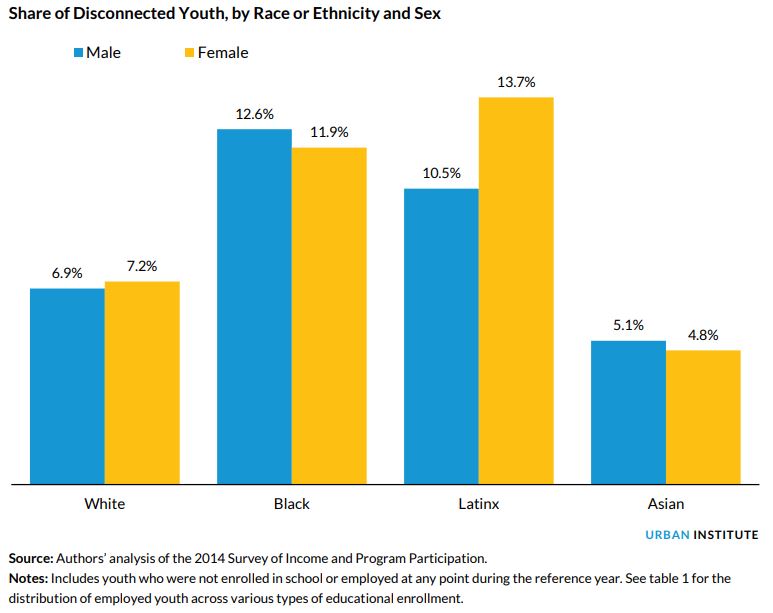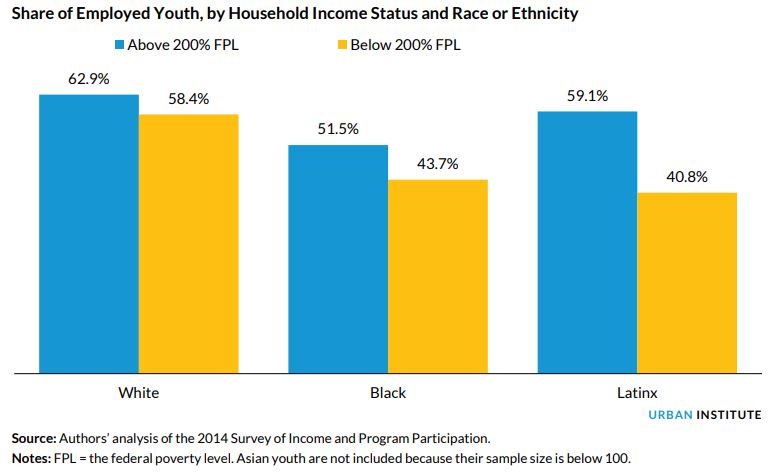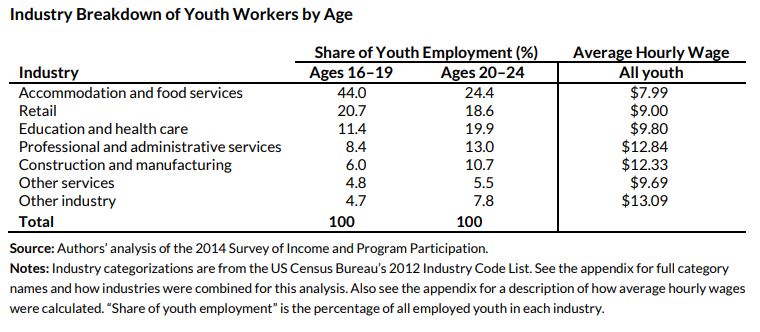
The belief that a good job is the surest path to economic security has always been at the heart of our nation’s political and social framework. Young people will soon drive our economy, and youth employment (defined here as employment for 16-to-24-year-olds) has positive implications for their future economic, academic, and health-related outcomes.
But for black and Latinx youth—who are already at a higher risk for many negative life outcomes—youth employment is yet another driver of disparities in opportunity and outcomes in a society where their prospects for socioeconomic mobility are already limited.
Our analysis of the 2014 Survey of Income and Program Participation reveals that black, Hispanic or Latino (referred to as Latinx in this post), and Asian youth were employed at much lower rates than white youth. And black and Latinx youth who did work were paid less than their white peers.
These disparities are concerning given what we know about the importance of youth employment. Young people who do not have stable jobs by their early twenties are at greater risk (PDF) of joblessness and permanently lower earnings, suggesting a longer-term effect of early work experience on socioeconomic mobility.
White youth are employed at higher rates than young people of color
The survey data show that white youth were employed at significantly higher rates than youth of color, and this disparity was largest among youth ages 16 to 19.

And although white and Latinx male and female youth were employed at similar rates, black male youth were 4 percentage points less likely to be employed than black female youth, and Asian male youth were 8 percentage points less likely to be employed than Asian female youth.
More troubling, black and Latinx youth were much more likely to be both not enrolled in school and not working than their white and Asian counterparts. These young people, often termed “disconnected youth” or “opportunity youth,” have lower future earnings, lower educational attainment, and higher rates of criminal justice involvement than their peers, and their economic burden manifests in lower economic growth, lower tax revenues, and higher government spending.
Among young white, black, and Asian people, male and female youth were disconnected at similar rates. However, Latinx female youth were 3 percentage points more likely to be disconnected than their male counterparts.

And though black and Latinx youth are more likely than white youth to live in low-income households, the racial and ethnic gap in employment rates persisted, even after accounting for income level.
Across all racial and ethnic groups, youth who lived in low-income households (earning less than 200 percent of the federal poverty level) were less likely to have a job than their higher-income counterparts, despite low-income youth being in greater need of both the immediate and long-term benefits a job can provide. The income-based employment gap was larger among youth of color than among white youth, and it was particularly large among Latinx youth.

Among working youth, wages are lower for black and Latinx people
Black and Latinx youth who were employed did not reap the same benefits of work as their white or Asian peers. For 20-to-24-year-olds, wages were highest among Asian youth ($10.77), followed by white youth ($10.18), Latinx youth ($9.32), and black youth ($8.77), highlighting how wage inequality emerges early in people’s lives.
Neither educational attainment nor the sector in which young people work explains this phenomenon. There was no wage gap between white high school students and black and Latinx high school students, but the gap emerged among college students and out-of-school youth. Additionally, black and Latinx youth didn’t work in low-wage industries at higher rates than white youth, and white youth didn’t work in high-wage industries at higher rates than black and Latinx youth.

Why do these disparities matter, and how can we address them?
Our findings paint a picture of disadvantage among black and Latinx youth. These disparities in employment and wages mirror trends that have been well-documented in the larger labor force.
The persistence of these gaps, even when accounting for differences in industry sector and educational attainment, points to the structural barriers these groups face when obtaining jobs. Black and Latinx people are more likely than white people to live in economically depressed neighborhoods and may lack access to good jobs, quality elementary and secondary schools, relevant social networks, and public transit. Research also shows that discrimination plays a role in hiring practices.
Evidence shows that well-designed summer youth employment programs, which have become a primary intervention to address high rates of youth unemployment, can increase earnings, reduce criminal justice involvement, decrease mortality, and improve academic outcomes through higher attendance and graduation rates.
These programs also prepare youth for the workforce by expanding their professional networks (PDF) and contributing to the development of critical “soft skills.” Most of these effects are stronger for disadvantaged youth and youth of color, suggesting that summer job programs may be a key intervention for combating racial inequalities.
Society bears the burden when all youth are not prepared for success in the workforce. These costs arise in the form of increased safety net expenses, repressed long-term economic growth, difficulty maintaining US global competitiveness, and increased criminal activity. By one estimate, if the nation closed its overall racial income gap, American gross domestic product (GDP) would increase by $2.1 trillion each year, which would have amounted to a 14 percent increase in GDP in 2012.
As the structure of the workforce continues to shift, we need tactics to ease young peoples’ transitions into the labor market—particularly for disadvantaged populations who are at greater risk of being left behind. Ensuring that all youth, regardless of race and ethnicity, can realize the far-reaching benefits of early employment is a critical step in this direction.
Tune in and subscribe today.
The Urban Institute podcast, Evidence in Action, inspires changemakers to lead with evidence and act with equity. Cohosted by Urban President Sarah Rosen Wartell and Executive Vice President Kimberlyn Leary, every episode features in-depth discussions with experts and leaders on topics ranging from how to advance equity, to designing innovative solutions that achieve community impact, to what it means to practice evidence-based leadership.